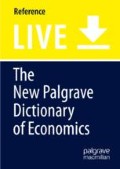Abstract
We document the increase in marital turnover and survey economic models of the marriage market. Couples match based on attributes but sorting is constrained by costs of search. Divorce is caused by new information on match quality, and remarriage requires further search. Although most men and women marry, they are single more often than before and more children live in one-parent household. The impact on children depends on child-support transfers. Such transfers may rise with the aggregate divorce (remarriage) rates.
This chapter was originally published in The New Palgrave Dictionary of Economics, 2nd edition, 2008. Edited by Steven N. Durlauf and Lawrence E. Blume
Bibliography
Becker, G. 1991. Treatise on the family. Cambridge, MA: Harvard University Press.
Bisin, A., G. Topa, and T. Verdier. 2004. Religious intermarriage and socialization in the US. Journal of Political Economy 112: 612–665.
Black, D., G. Gates, S. Sanders, and L. Taylor. 2000. Demographics of the gay and lesbian population in the United States: Evidence from available systematic data sources. Demography 37: 139–154.
Browning, M., and P. Chiappori. 1994. Efficient intra-household allocations: Characterization and empirical tests. Econometrica 66: 1241–1278.
Browning, M., P. Chiappori, and Y. Weiss. 2005. Family economics. Cambridge: Cambridge University Press.
Burdett, K., and M. Coles. 1999. Long-term partnership formation: marriage and employment. Economic Journal 109: F307–F334.
Chaippori, P., B. Fortin, and G. Lacroix. 2002. Marriage market, divorce legislation, and household labor supply. Journal of Political Economy 110: 37–72.
Goldin, C., and L. Katz. 2002. The power of the pill: Oral contraceptives and women’s career and marriage decisions. Journal of Political Economy 110: 730–770.
Gould, E., and D. Paserman. 2003. Waiting for Mr Right: Rising inequality and declining marriage rates. Journal of Urban Economics 53: 257–281.
Lundberg, S., and R. Pollak. 1993. Separate spheres bargaining and the marriage market. Journal of Political Economy 101: 988–1010.
Lundberg, S., R. Pollak, and T. Wales. 1997. Do husbands and wives pool resources? Evidence from UK Child Benefit. Journal of Human Resources 32: 463–480.
Michael, R. 1988. Why did the divorce rate double within a decade? Research in Population Economics 6: 367–399.
Mortensen, D. 1988. Matching: Finding a partner for life or otherwise. American Journal of Sociology 94(supplement): s215–s240.
Piketty, T. 2003. The impact of divorce on school performance: evidence from France, 1968–2002. Discussion Paper No. 4146. London: CEPR.
Roth, A., and M. Sotomayor. 1990. Two sided matching: A study in game-theoretic modeling and analysis. Cambridge: Cambridge University Press.
Weiss, Y., and R. Willis. 1985. Children as collective goods. Journal of Labor Economics 3: 268–292.
Weiss, Y., and R. Willis. 1997. Match quality, new information, and marital dissolution. Journal of Labor Economics 15: S293–S329.
Willis, R. 1999. A theory of out-of-wedlock childbearing. Journal of Political Economy 107(6): S33–S64.
Wolinsky, A. 1987. Matching, search, and bargaining. Journal of Economic Theory 42: 311–333.
Author information
Authors and Affiliations
Editor information
Editors and Affiliations
Copyright information
© 2008 The Author(s)
About this entry
Cite this entry
Weiss, Y. (2008). Marriage and Divorce. In: The New Palgrave Dictionary of Economics. Palgrave Macmillan, London. https://doi.org/10.1057/978-1-349-95121-5_2626-1
Download citation
DOI: https://doi.org/10.1057/978-1-349-95121-5_2626-1
Received:
Accepted:
Published:
Publisher Name: Palgrave Macmillan, London
Online ISBN: 978-1-349-95121-5
eBook Packages: Springer Reference Economics and FinanceReference Module Humanities and Social SciencesReference Module Business, Economics and Social Sciences

